Cows, goats, donkeys, chickens and dogs…the villagers of the Transkei have dubbed these five animals their very own Big Five (fun fact). The difference between this Big Five and South Africa’s so-called Big Five? These animals roam freely – no fences restricting them, they are accustom to traffic, spotted frequently during your travels and definitely don’t require a booking at an expensive safari lodge. There are not many places in the Transkei that you won’t get to without an adventure down a bumpy dusty road, each one curling and zigzagging around hundreds of magical hills. Brightly coloured thatched huts are sprinkled all over the grassy terrain, it’s the type of landscape an artist or photographer would dream of capturing and to see these landscapes first hand was a wonderful experience.
I have visited the Transkei before a few years ago, but only very briefly. Jeremy had only ever seen pictures. It was for these reasons that we decided to plan a week long roadtrip to explore this exotically wild part of the Eastern Cape. An area right on our very doorstep, but a place we knew very little about. Our travels began on a fine Sunday morning in April.
Our Wild Coast Adventure
Sunday, 09/04/2017 Day 1: Port Elizabeth – Morgans Bay
After an early start to our Sunday morning, we hit the tar road, car packed to the brim, Jack Johnson quietly serenading us through the speakers. We engaged in excited chatter about the days ahead. After about 40 minutes, a standard pitstop was made at Nanaga Farmstall for some breakfast pies. Pastry for breakfast you say? *insert judgement here* Anyone that has ever tasted a Nanaga pie will understand my thought process here. Had it been afternoon – then lunchtime pies, had it been evening – then suppertime pies…you catch my drift. Nanaga is a popular farmstall and restaurant just off the N2 between PE and Port Alfred. Scrumptious pies are always on the menu. No sooner were we back in the car and our pies had been devoured.
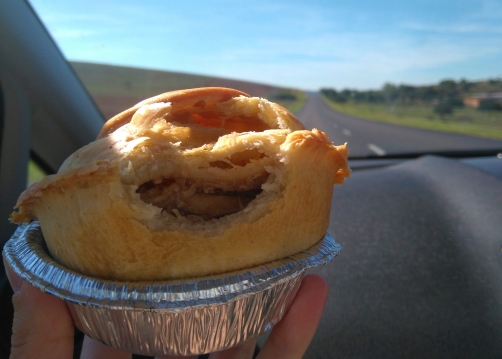
Chicken pie….mmmmm!
We drove for another two hours, only just reaching the very tip of the Transkei at this point, we could tell by the lack of huts and animals alongside the highway. If you have ever heard stories of travelling through the Transkei you will have been warned about the ‘Big Five’ and their attraction to the busy highway. Unfortunately many of these animals are run over or cause serious car accidents, so keeping your eyes peeled and slowing down as you drive through villages is of utmost importance.

After a fairly easy drive we arrived. Morgans Bay is a quaint little holiday town with not too much going on. You’re either at the beach or dining at one of the hotels restaurants. Upon arrival, we followed a gravel road to Yellowwood Forest, our accommodation for the next two nights. Surrounded by an array of trees and plant life, the campsite lives up to its name confidently. Arriving on a Sunday, we had just missed the popular Saturday market that takes place there, but never-the-less the resort offers lots to do.
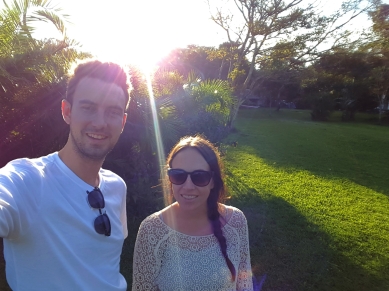
We stayed in the Campers cabin, which was a small forest shack that had the bare essentials only – bed, fridge, small desk top stove and some storage space. Cozy and exactly what we needed. We used the ablutions for toilets and showering. Rustic, but clean. Perfect type of accommodation if you don’t plan on spending too much time indoors and just need a place to catnap for a few hours.
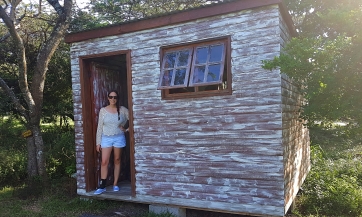
We dropped off our belongings and took a drive into the tiny town to explore. We drove through the quiet hilly neighbourhoods which mostly consisted of clusters of locked up holiday homes yearning for the Summer holidays, and landed up near the beachfront. Our rumbling tummies got the better of us and we decided to head back to have some supper at the pizzeria at Yellowwood. The fine weather was perfect for a meal at the pizzeria as the majority of the restaurant is outdoors and covered partially by a tented roof. We ordered a margarita pizza and some cocktails and relaxed to the setting rays of the sun as they shone brightly through the canopy of trees around us.
The pizzeria only serves vegetarian pizzas as a sign of respect for it’s founders. The story goes that many years ago, two Dutch travelers who took a liking to the area, decided to camp there in their Tee-pee for some time. They built the small pizza oven on site to cook for family and friends. On the foundation stone on which the oven is built, they wrote the simple prayer:

When their Tee Pee burnt down, the travelers moved on asking only that their oven remain vegetarian and karma free. And so Yellowwood has kept this promise and offers a variety of creative veggie pizza options.
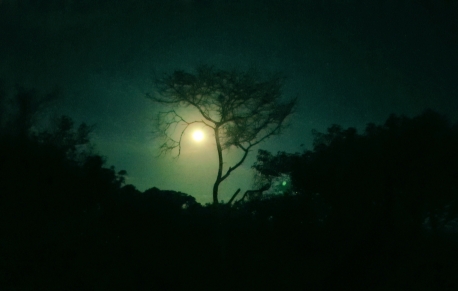 Stargazing next to a small campfire, our ears filled with the sounds of the crickets busily chirping and the fire wood silently crackling and the feeling of the cool night air breezing over us – this is how we ended Day 1 of our road trip.
Stargazing next to a small campfire, our ears filled with the sounds of the crickets busily chirping and the fire wood silently crackling and the feeling of the cool night air breezing over us – this is how we ended Day 1 of our road trip.
Monday, 10/04/2017 Day 2: Morgans Bay
We awoke to the sound of the rain gently splashing upon the cabin’s tin roof. Our windows did not have curtains and we welcomed the early wake up call from nature as we gazed out at the view from our bed. The sky was quietly showing off it’s colours as dawn approached and the large tufts of clouds slowly glided away.
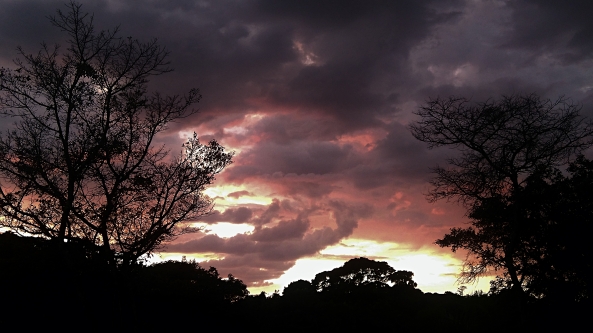
Having had awoken with the birds, we decided to saunter along the Bushbuck trail on the Yellowwood premises. This is a magical walk in the forest with something exciting to discover around every corner. The trail is marked with fun and qwerky facts that are pinned to the trees along the route and painted yellow bottle caps along the path catch your eye as you go and make sure you never lose your way. As you begin, you are welcomed by a Fairy Grotto which is home to a number of weird and wonderful fairy figurines and ornaments hiding behind rocks and among the overgrown plants.
Next you’ll come across the Massive fig tree with a tunnel, big enough to crawl through, in its trunk. If you’re lucky you may spot an otter in the small dam behind this tree. Monkey Swings are next on the route, a large entanglement of vines hanging from the treetops just asking to be swung on. There is a Tree Swing hidden to the side of the path as you move further along and many low lying branches that you can clamber upon along the way. Towards the end, you will squish into The Swamp, a muddy sludgy section at the side of the dam, covered in reeds just about the length of you. My turquoise Nikes were never ready for the damage done here, nor were my legs. The reeds have sharp edges that scratch you as you wade through them (that’s if you’re wearing shorts) and your feet sink into the mud as you step. Bear in mind that we did tackle the swamp after a few hours of rain. Besides some battle wounds from the reeds, the trail is an enchanting walk for both children and adults alike and we thoroughly enjoyed this little wonder in the forest.
After breakfast and a clean up we decided to go and explore the town a little. We drove down to the beachfront and eventually decided to follow a tiny gravel road up a grassy hill. We came across a lookout spot that surprised us with an epic view of the coastline. A short walk down an overgrown footpath lead us to a platform of rocks that extended over hundreds of pebbles and smooth stones that the low tide had exposed. We spent until just before lunch watching the waves roll in and fresh ocean breeze .
Our second discovery for the morning was a tiny convenience store right at the top of the hill that slopes down to Morgan’s Bay. This store looked like nothing from the outside, but inside it pretty much had everything you could think of, from fresh fruit and veggies to spades and buckets for the beach. We stumbled across it at the perfect time, the small bakery at the back of the shop had just laid out freshly steaming loaves of bread, there aren’t many smells in the world that can beat that smell. We stocked up with the vegetables and meat we needed for our braai later and of course a fresh loaf of bread was added to the basket – it was too irresistible. By the time we got back to Yellowwood, the heat of the day was in full force. We found a shady spot to retreat to and read our books….and shortly after we gave in to a warm slice of buttery bread. Our tranquil moment didn’t last too long as the rain from the previous night had brought along with it a gazillion newly hatched mosquitoes looking for their first meal. Our legs fell victim to their wining and dining, nevermind our great efforts to plaster ourselves with Ta bard. So off to the beach it was. Double mouth, a popular beach near the Morgan Bay campsite,
was packed with families. As the name indicates, the beach is where the Kei mouth meets the Indian ocean. There were lots of parents and children frolicking in the shallow lagoon, not so many people in the ocean as the waves were a bit crazy. Jeremy bravely took a dip in the cool ocean water while I decided to work on my tan. At some point a massive gust of wind got up and for a moment the beach became a stage of colourful dancing umbrellas, towels and inflatables with people running in disorganized chaos. And just like that, the beach emptied, bowing down to the mercy of Mother Nature.
The wind brought with her an army of grey uniformed clouds. We decided to get back to Yellowwood to outrun the rain and start our braai early. 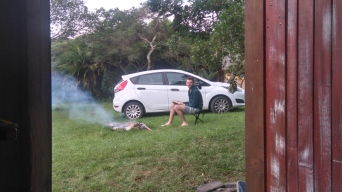 We managed to finish just as the first drops of rain started. Along with our braai meat and salad we made sweet potatoes on the coals – was one of the sweetest most delicious sweet potatoes I’ve ever had. The farmers must be doing something magical to their crops in Morgans Bay. And so, like that, our second day came to end.
We managed to finish just as the first drops of rain started. Along with our braai meat and salad we made sweet potatoes on the coals – was one of the sweetest most delicious sweet potatoes I’ve ever had. The farmers must be doing something magical to their crops in Morgans Bay. And so, like that, our second day came to end.
Tuesday, 11/04/2017 Day 3: Morgans Bay – Nqileni
Our next stop was Bulungula Lodge situated in the rural village of Nqileni. We got up early so that we could conquer the 4.5 hour journey to get there. We took the highway towards Mthatha for 2 hours of the trip and then had to take the Coffee Bay turn off. From here we navigated our way down many twists and turns until we reached the gravel road and once the gravel roads began…they didn’t stop…nor did they get easier to drive on. Unfortunately for us it had rained the night before so all the roads were still full of puddles and mud.
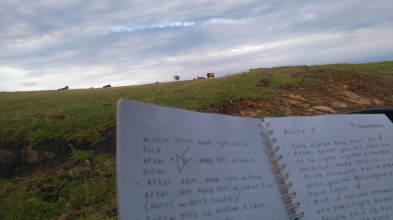
I had to write down the directions as our GPS kept losing signal on the way.
Let’s just say that emotions were heightened and the car spent a good part of the journey sliding and slipping around as though we were going down a muddy water slide. Massive potholes, hundreds of loose rocks ricocheting in every direction and no reception or form of civilization for large spans of the route, just add some mist and rain and you have an idea of the ordeal we endured. Hats off to Jeremy’s Ford Fiesta for tackling the road so well, she lost a hubcap but did pretty well considering the only other vehicles we saw attempting the roads were 4X4s. We made a wrong turn at one point and had some old man wave us down to tell us to turn around, in very broken English. He gave us directions which we managed to decipher by watching his hands move and point. If it wasn’t for him we would have ended up who knows where. Bless his soul.

Upon arrival, the car that had morphed into a dirty brown beetle. As if our nerves weren’t already shot, we had to walk another 1km from the parking area, with all our luggage…in the rain…up a hill, to Bulungula Lodge. 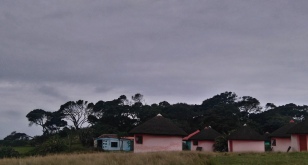 Sopping wet from head to toe, our luggage soggy and having about as much patience left as a horse fly, we stumbled to the top of the hill…and boy was the view worth it. Brightly painted peach holiday huts were sprinkled all over the hill overlooking the ocean, to the left of the lodge was a river mouth with water gently lapping at the sandy embankments and to the front of the lodge was an endless white beach. We traipsed a few more metres and finally reached our second destination.
Sopping wet from head to toe, our luggage soggy and having about as much patience left as a horse fly, we stumbled to the top of the hill…and boy was the view worth it. Brightly painted peach holiday huts were sprinkled all over the hill overlooking the ocean, to the left of the lodge was a river mouth with water gently lapping at the sandy embankments and to the front of the lodge was an endless white beach. We traipsed a few more metres and finally reached our second destination.
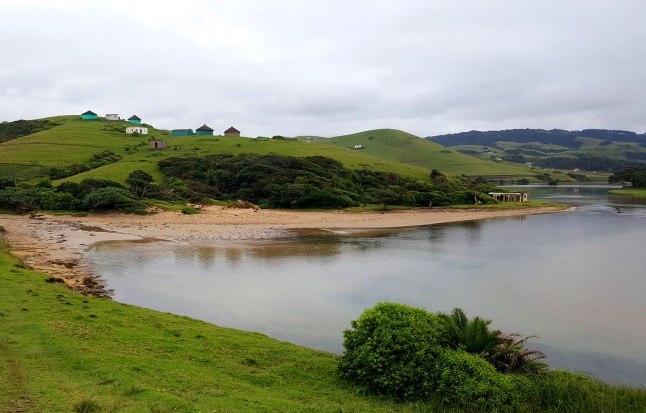
Welcome to Bulungula 🙂
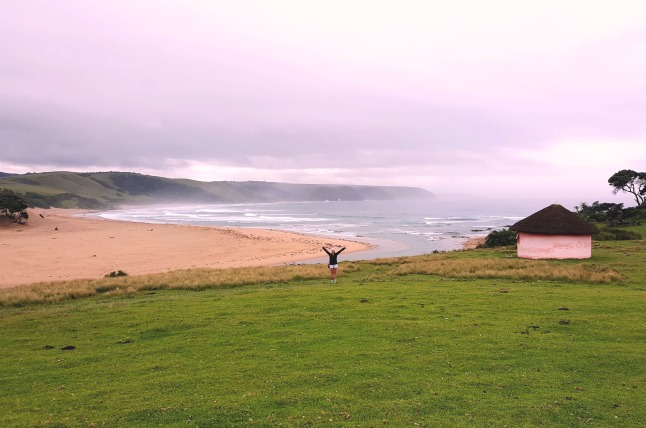
Beautiful, despite the clouds!
Bulungula Lodge is less “lodge-like” and more like a backpackers. With a large communal area and kitchen, the lodge offers a variety of accomodation from hut-living, to deck tenting to plain old camping. It is a community run centre that provides jobs to villagers nearby and your stay here promises authenticity at its best. Legitimate African food, compost toilets(no flushing here), rocket showers, bonfires and socializing with the Transkei born and bred. One will also begin to understand where the term ‘African time’ originates from after spending some time there. Everything is done at the pace at which it can be done and ‘stress’ is a foreign word. There are a lot of activities on offer, from a guided tour of the village, to bead-making with the village ladies, or drinking homemade beer at the local shabeen, sandune sunrises with breakfast pancakes, canoeing down the river mouth or a day spent at the pristine beaches.
We learnt of a Bulungula legend while waiting in the communal lounge, a news clipping upon the wall told of a tale: locals are believed to occasionally hear the singing/humming of a man during the night, his voice is carried by the wind on really quiet evenings. Legend has it that this man was born mentally disabled and one night when he was very young, he wondered out of his home and got lost among the many hills. He was never to be seen by his family again. Sightings of him have been made all over the vast Transkei, as he sometimes approaches local huts to steal food. But after years of solitude and little human interaction, he is happiest on his own and singing upon the hills. The clipping told us that he is a harmless being with animal-like tendencies and if spotted we should place some food on the ground for him and then let him be.
After a gigantic toasted cheese and tomato sandwich (each bread slice was the equivalent to 4 normal bread slices and toasted over a fire) we were taken to our accommodation. We stayed in a deck tent that almost hung among the trees like a tree house. The surrounding trees leaned away from the beach and consisted of many low lying branches that entwined to form a leafy roof above our tent. Our tent had a beautiful view of the ocean and lush green scenery all around – the best of both worlds.
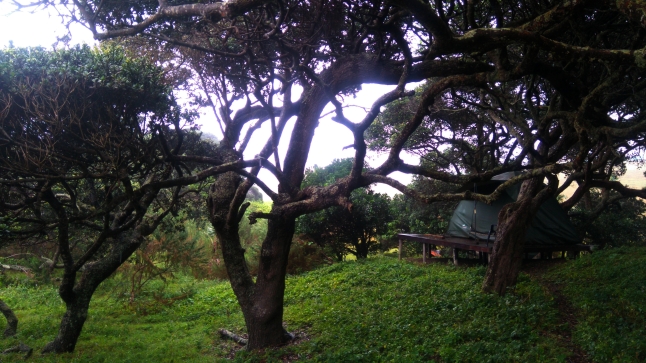
Just a little bit in front of our tent, was what at first looked like a broken tree branch, but we later realised that it was a washed up vertebrae of a whale skeleton.
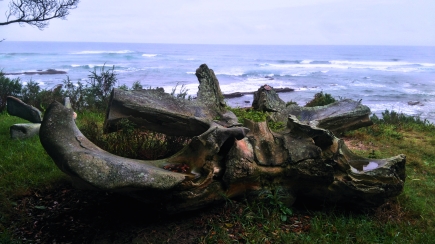
An Ocean view seated upon a whale vertebrae…anyone?
It was fascinating to look at and made me fathom just how massive a whale could be if the size of one vertebrae was big enough for two people to sit on. The bone structure had become one with nature and had moss and small weeds growing from its crevices – the incredible circle of life.
Overcast or not, the fist activity on my agenda was to get to the beach and go shell combing. The thought of all the undiscovered shells along the quiet stretch of beach was exciting. I have had a fascination with shells since I was a little girl – I love the beautiful colours and patterns of each shell and the amazing journey that these delicate structures make through the strength of the ocean’s crashing waves, safely onto a beach.
We took a long walk along the beach, there was nobody else around as far as the eye could see. The clean, white sand hugged the coastline and the beachy vegetation stood back a few metres as if bodyguarding the pristine beaches. It was so refreshing to be so far away from civilization, my lungs were filled with the cleanest air.
That night we joined the rest of the guests and locals around a bonfire while we waited for supper. We chatted to a few foreigners and got to know a few of the locals and we were even invited for pancakes the next day by a young lady that lived further up in the village. Later on we found out that she works at the legendary iLanga Fire Restaurant whose slogan reads “the best sweet and savoury pancakes in Africa.” Another local told us all about the way of living in the Transkei and how he had only left the area once. It was very interesting hearing his take on life. The community has such a strong sense of the traditional value of Ubuntu, “What’s mine is yours”. Caring and sharing comes naturally to all that live there and you can’t help but feeling safe.
We had supper in the communal lounge area which had turned into somewhat of a shabeen at this point – lots of people enjoying drinks and dancing to some kwaito music. Many of the Bulungula staff’s children joined us for supper too. It felt more like we had been invited to someone’s home for a supper party than eating at a lodge, it was a great experience. I felt so welcome and as if I were a member of their family. We had Umngqsho for supper (samp, beans and meat concoction) with some salad on the side – a proper African recipe – one I’d heard a lot about but had never tasted. It was not my most favourite meal in the world, but it was tasty and boy did it keep me full for hours. I did not even need breakfast the next day.
Wednesday, 12/04/2017 Day 4: Nqileni – Lusikisiki – Port St Johns
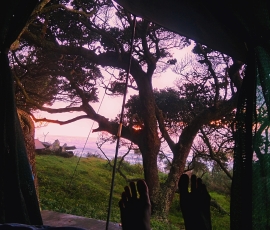 We woke early to the sounds of the sea crashing loudly and sweet sounds of the birds singing as the first rays of light climbed gradually into the sky. We opened the zip of our tent and let the morning daylight filter in. It was so amazing to lie in bed and watch the sunrise.
We woke early to the sounds of the sea crashing loudly and sweet sounds of the birds singing as the first rays of light climbed gradually into the sky. We opened the zip of our tent and let the morning daylight filter in. It was so amazing to lie in bed and watch the sunrise.
We decided to head down to the beach and get a better look. There is something about the morning rays of light that make everything look so magical.
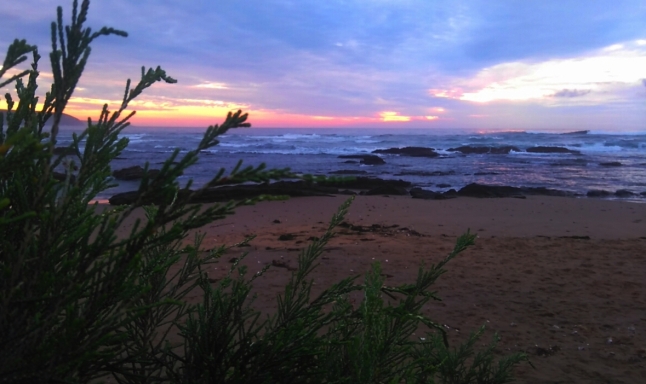
One of the most peaceful sunrises I’ve seen.
All was quiet and we were the only guests in the lodge that were awake, besides the birds and the bees. We were lucky enough to see a mother hen and her chicks quietly tiptoeing around the gardens in search of some grub….i guess the early bird catches the worm.
We decided to get packing and get on the road quite early as we had another long trek ahead of us. It was difficult to leave this breath-taking place, I only wish we had had more time to expore. We gathered our belongings and started the 1km walk back to the car park. This time it was done in ease and far more calmly. As we were leaving a local man with our hubcap in his hand tried to wave us down, but having grown accustom to the friendliness of the villagers we just waved back and laughed when he pointed at the hubcap not once thinking it was ours. When we stopped at the petrol station a few hours later, we came to the realization that it was ours *face palm*
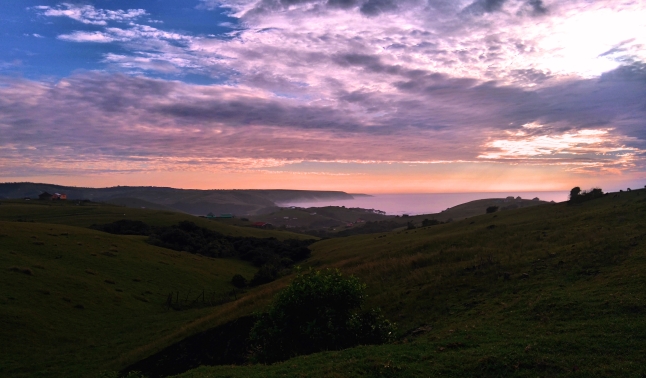
The magnificent morning view as were leaving.
It was a peaceful drive with no rain and no other traffic beside a few children still in their pajamas that had been sent to collect buckets of water.
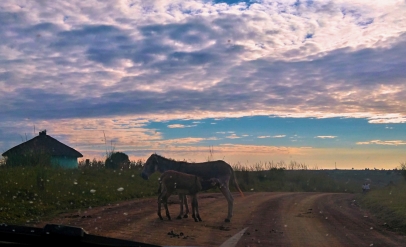
A donkey and its baby.
Children get very excited when they see a car with foreign people and normally run next to the car shouting “SWEETS!!” A habit that was started when tourists gave sweets to children when passing by. We were told by the locals not to give the children sweets as the community believes in equality. By doing so it is emphasizing that the children are receiving something they themselves cannot afford and projects one social class above another. To be honest it is just downright dangerous – a child could be driven over or hurt by the moving car they are running next to. We were told that the community leaders and chiefs in the area want to educate others entering their community of their values to help discipline the children.
Our directions were not so easy to follow when navigating back to the highway, bear in mind we had to read them in reverse as I had only written them down one way. In the end we got back to the highway using snippets of the GPS that were available and our own instincts.

We arrived in Port St Johns after a trip through a very congested Mthatha and about a dozen roadworks. Port St Johns is a very run-down town bustling with locals going about their daily business, but otherwise a very quiet and sleepy town. 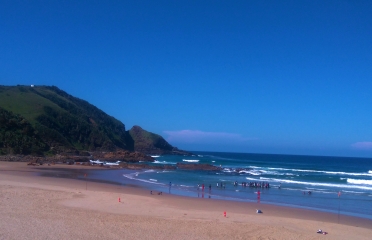 It lies at the mouth of the Mzimvubu River, a river flowing through an impressive gorge known as the Gates of St John.
It lies at the mouth of the Mzimvubu River, a river flowing through an impressive gorge known as the Gates of St John.
On both sides of the river are high sandstone mountain peaks. Trying to get our bearings, we decided to take a drive around and orientate ourselves. We immediately came across to the well-known First, Second and Third beaches – beautiful stretches of sand colliding with the shrubby hills that divide beach into sections. We didn’t spend much time at there as our tummies were empty and our mouths thirsty.
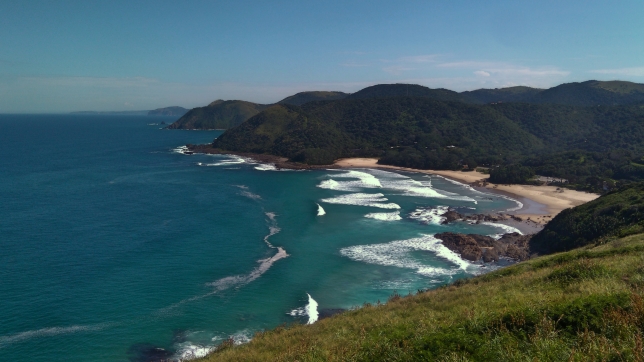
We did however drive to the top of one of the hills above the beach and view the three beaches from the top. The drive along the top of the hill was quite something as the road was literally on the edge – a shear drop as you gazed out of the window.
We stopped at a pub called Steves for a bite to eat. 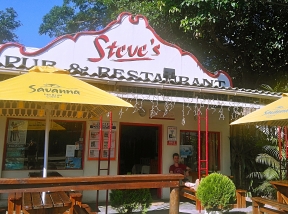 Hamburgers and beers were on the menu, just what we needed. We ate our grub on their patio and spent a good hour enjoying the hustle and bustle of the town and mapping out our plan for the afternoon – an hour drive out to Lusikisiki to see a beautiful waterfall.
Hamburgers and beers were on the menu, just what we needed. We ate our grub on their patio and spent a good hour enjoying the hustle and bustle of the town and mapping out our plan for the afternoon – an hour drive out to Lusikisiki to see a beautiful waterfall.
Magwa Falls is situated 8km north of Lusikisiki on one of the only tea plantations left in South Africa. It was a race against the sun as we only had three hours to drive there and back before sunset and Lusikisiki is an hours drive from Port St Johns. The road took a series of zigzags winding in and out of the mountains until we reached the town. We then followed a long, narrow road out into the country. As we arrived at the tea plantation, we turned onto a gravel road that the rain had turned into a great muddy mess, some areas had become pure sinking sand waiting to devour car tyres. Navigating through the sludge was almost as fun as our trip to Bulungula *insert curse word here.*
The car finally crawled onto a grassy space upon the edge of a massive gorge. We stopped the car and turned the engine off. Silence. No signs giving directions, no other tourists around, no nothing. Then out of the blue, just as we were about accept that we had taken a wrong turn, a 12 year old local boy appeared at the side of the car. I had read a few warnings online about being careful when allowing the boys to look after your vehicle or guide you, as one child may become a gang of kids looking for tips – so I was very weary at first. But we honestly would not have found the waterfall without Dumi. His friend, a younger boy that was less fluent in English, also suddenly sprouted up and asked if he could watch our car. 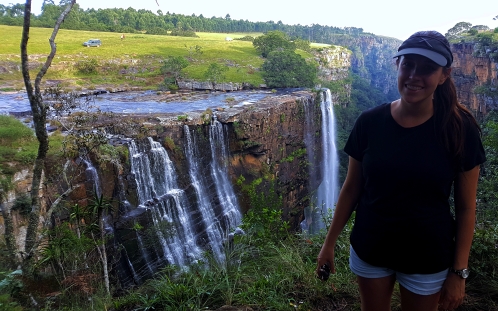
After a brief chat with Dumi, we followed him along the edge of the ravine. He took out a fancy IPAD from his pocket and put on some tunes for the walk – an added perk of a 12 year old guide haha. After a short walk, we reached an epic spot to view the Magwa falls.
The curtain of water falls 144 metres and drops into a narrow canyon and is quite a sight to see. Rumour has it that the falls resemble the Victoria Falls in Zimabwe, at a far smaller scale of course. Dumi told us some interesting information, including the legend of a man that drove his car off the waterfall when he came looking for it at night time. 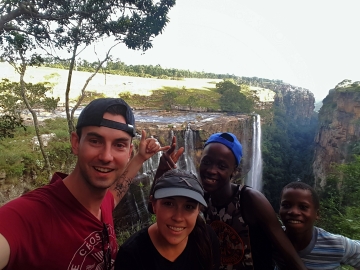
He mentioned that there used to be a lady that lived on the edge of the cliff overlooking the falls, but relocated as the locals in the area claimed that it was their king’s land. Her house is still visible form the other side of the waterfall. There are also many tourists that like to camp right at the edge of the falls – imagine what a beautiful sight it would be to wake up there.
After a few photo opportunities, (this included posing for a photo for Dumi’s Ipad collection – he kept evidence of his previous clients to show any untrusting and timid tourists that he was “The real deal” haha) the sun began to slip behind the hills. On the way back to our car we chatted to Dumi a little more. He told us that he had never left the Lusikisiki area and attended school on the tea plantation, his parents had jobs at the plantation too. He asked us a little about ourselves and was amused by the fact that I was a teacher. We gave our impromptu guide and his friend a tip for their kindness and bid them farewell. We got on the road back to our accommodation for the night, Cremorne Holiday Resort. The sun was setting and the clouds were threatening to burst at any moment. At first glance, we could immediately see the resort was surrounded with rich, lush vegetation and had beautiful well-kept gardens. The staff were friendly and we checked in quickly.
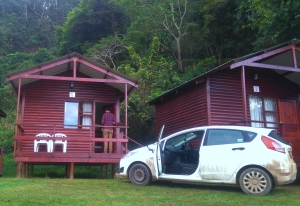
We stayed in a Fisherman’s cabin right on the banks of the Mzimvubu River. The cabin was just big enough for a double bed, a bunkbed and some storage space and was nice and cosy. Our neighbours, a father, son and grandfather trio, were staying next door to us – and these guys were actually fishermen. They mentioned that National Geographic were going to be booking the whole resort during the months of June/July for the annual Sardine Run – thousands of sardines making their way in shoals from the cold Cape waters up the coastline to the warmer waters of KwaZulu Natal.
Exhausted after our day of adventure, we resorted to a much needed hot shower and a simple supper in bed. There is a restaurant in the resort, but our eyes could not stay open much longer so we resorted to cheese and crackers.
Thursdy, 13/04/2017 Day 5: Port St Johns – Coffee Bay
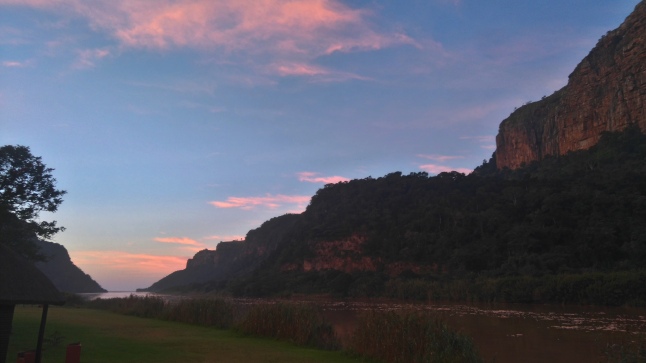
The Gates of St John as seen from our cabin at dawn.
Another early morning saw us on the road again – we had reached the furthest destination of our trip and were now heading en route Port Elizabeth. After setting the GPS incorrectly, I gave Jeremy alternative directions to our next destination – Coffee Bay.
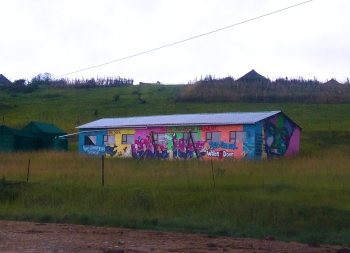
“Education is the most powerful weapon we can use to change the world.” Nelson Mandela. Wise words on a school building.
We drove along gravel in the middle of absolutely nowhere for the best part of two hours, living on a prayer that our car wouldn’t break down. We ended up arriving in Coffee Bay 30 minutes ahead of time, so it turns out my terrible directions were in face a short cut and probably the more scenic route.

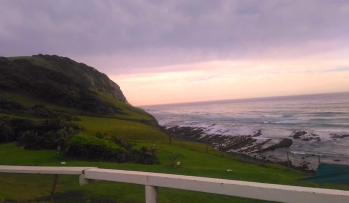 We arrived in a very gloomy looking Coffee Bay at around 11 o clock. We were able to check in to White Clay Holiday Resort two hours early, which was fantastic. Our room was on the ocean’s doorstep and had a beautiful view of the bay that could be seen through its large glass sliding doors.
We arrived in a very gloomy looking Coffee Bay at around 11 o clock. We were able to check in to White Clay Holiday Resort two hours early, which was fantastic. Our room was on the ocean’s doorstep and had a beautiful view of the bay that could be seen through its large glass sliding doors.
While at reception we asked what the walking distance was from the resort to the well-known ‘Hole in the Wall’ – a large tidal island bearing a majestic natural arch in its centre. It was a 10km hike and the receptionist recommended that we use a guide. We managed to hijack a guided hike that was just about to leave and left our luggage in the car for unpacking later.
Justus, our guide and a local from Coffee Bay, lead the way down a narrow set of stairs landing us on a small beach cove. We were joined by John, a friendly and easy-going guy from Durban who was also in search of a trip to the popular landmark. Once upon the beach, we ascended up a grassy embankment, interrupting a few grazing cows.
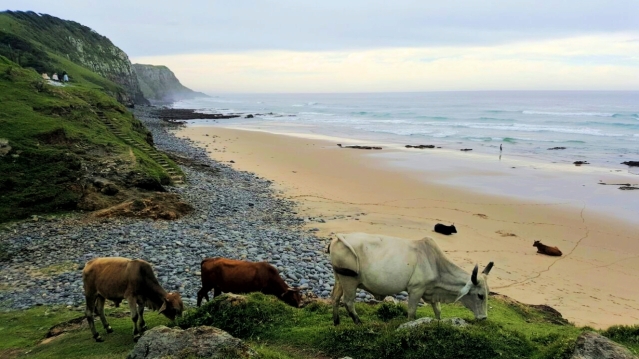
cows are unlike any cows that I have ever seen before. They are damn adrenaline junkies to say the least. These cows swim in the ocean, tolerating the beating waves on their bodies, they also climb up to the most ridiculous heights in order to graze. Along our hike we saw a few of them unsteadily balancing on the edges of deep gorges and cliffs, stupidly risking their lives for those apparently extra juicy and untouched blades of grass. We also nearly got charged by one of the bulls along the way, I guess we were stepping on his turf, but Justus knew just how to handle him.
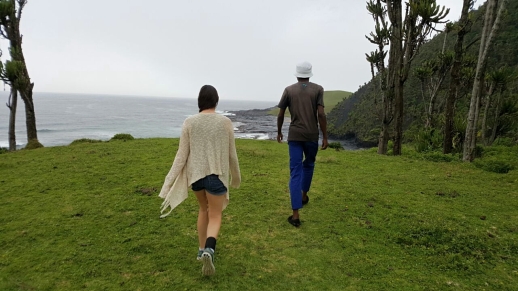
The weather turned miserable shortly after we began, but we welcomed the cool drops on our faces as we hauled ourselves up and down the grassy hills. Along with the rain come a game of slip and slide. Sections of the terrain were steep and muddy and we had to fight our feet from fleeing out from under our bodies. We witnessed some beautiful scenery along the way, the views from the top of the hills were absolutely breathtaking. About halfway along, Justus pointed out a spectacular rock formation that the locals call “The other Hole in the Wall”. Not many people know about it, so it was awesome to get the opportunity to see it.
About 2 and half hours later, after descending down a very slippery hill, we finally arrived at the The Hole in the Wall. It was not the first time I had seen it, but it was just as epic seeing it the second time around. The well known title was given to the feature when, over time, a hole was carved by the powerful friction of the waves against the rock face. 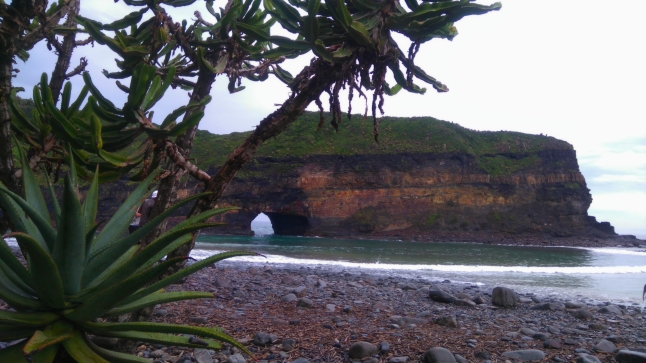
Justus told us briefly of the local legend surrounding this magnificent feature.
“According to Xhosa folklore, the Hole in the Wall is the gateway to their ancestors. They claim that the Mpako River running through the Hole in the Wall once formed a landlocked lagoon as its access to the sea was blocked of by a cliff.
Legend tells the story of a beautiful girl who lived near the lagoon. She would sit on the edge of the cliff and stare out to the sea. Unlike her people who were land people and feared the sea, she was attracted to its power and the way in which each wave was different. And so, one night, she went beyond the cliff to the shore of the sea. Out of the waves came one of the sea people. He was as tall as she was, with silky flowing hair like the waves. He had supple wrists and ankles and flipper-like hands and feet. He said he had watched her often and admired her, and now he had come because he wanted her to be his wife.The girl told her father about the man from the sea but her father would have none of it and shouted “We do not trade our daughters with sea people!” and forbade her from ever seeing him again. But the girl slipped away in the dark to meet up with her sea lover and told him of her father’s response. Her sea lover said she must wait until high tide to see how he would prove his love for her. This she did, with the suspicious villagers following her. The villagers saw thin willowy sea people on top of the cliff carrying a mighty fish that they used to batter the rock, carving a hole through the centre of the cliff and creating a passage from the lagoon to the open sea. With the force of the tide behind it, a great spout of water gushed through the Hole in the Wall, and on the wave came hundreds of sea people singing and shouting with joy. Riding the wave in front of them was the girl’s sea lover. He stretched out his arms and the girl moved to join him. As the wave retreated, foaming and frothing, the girl went with the sea people back through the hole in the rock wall and was never seen again.
According to Xhosa people, on nights when the tide is high, the sea people can be heard above the roar of the waves as they rush through the Hole in the Wall in their search for a bride.” Source
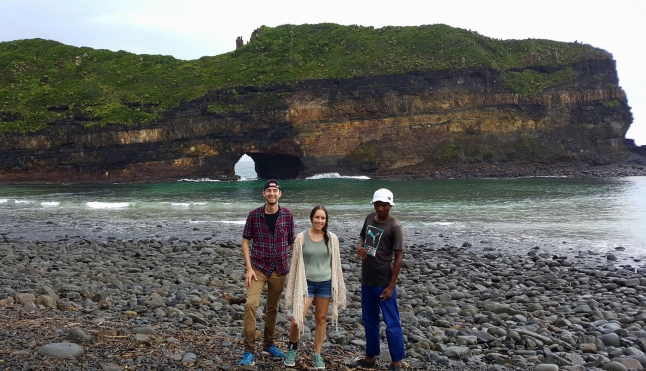 Our hike had worked up quite an appetite and our new friend, John, was kind enough to buy us some lunch at The Bell Buoy, at The Hole in the Wall resort before we started back. We had a great time chatting about our lives and random things. Luckily we did not have to walk all the way back, Roy from White Clay drove over to fetch us. Back at the lodge, we had a much needed nap as it continued to drizzle quietly outside. That evening we ate supper at White Clay’s restaurant where we had the most amazing prawn supper while overlooking the constant rumbling ocean. That night, I probably had the best night’s sleep that I had had all week. The sound of the ocean and my worn out muscles completely knocked me out.
Our hike had worked up quite an appetite and our new friend, John, was kind enough to buy us some lunch at The Bell Buoy, at The Hole in the Wall resort before we started back. We had a great time chatting about our lives and random things. Luckily we did not have to walk all the way back, Roy from White Clay drove over to fetch us. Back at the lodge, we had a much needed nap as it continued to drizzle quietly outside. That evening we ate supper at White Clay’s restaurant where we had the most amazing prawn supper while overlooking the constant rumbling ocean. That night, I probably had the best night’s sleep that I had had all week. The sound of the ocean and my worn out muscles completely knocked me out.
Friday, 14/04/2017 Day 6: Coffee Bay – Cintsa
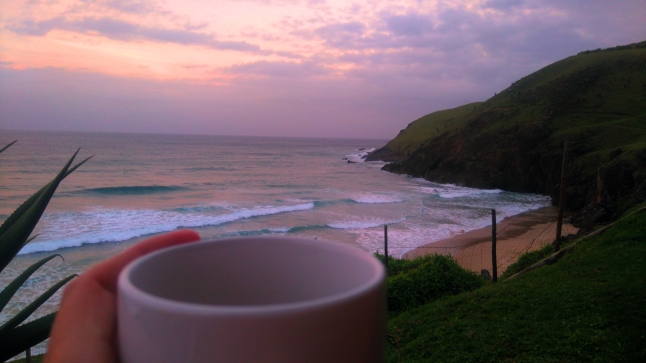
Tea at sunrise from our patio
Another early morning, a quick cuppa and we were on the road to our last destination, Cintsa.

We arrived in Cintsa in the late afternoon. We checked into Areena Riverside Resort and set up camp next to the river. Areena is a friendly resort with so much going on, the place is abuzz with families and couples enjoying the activities on offer. Guests are given the opportunity to meet a giraffe, go on a sunset boat cruise or take a drive around the wildlife park on a quad bike, to name a few. 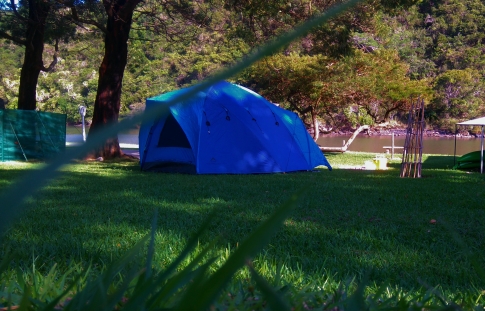
Our energy zapped after an action packed week of travelling, we decided to have a lazy afternoon braai and enjoy the view from our campsite. We lay outside reading our books in the gentle breeze. As the evening crept closer, so did the cooler weather. The wind picked up and brought with it a slight cold front. Luckily we ate early and retired to our tent for an early night. Besides our tent’s zip breaking and our neighbour snoring rather loudly in his caravan, we had a comfortable night’s sleep.
Saturday, 15/04/2017 Day 7: Cintsa – Port Elizabeth
Easter Sunday morning coincidentally brought with it a visit from a few bunnies. The were bold little things and came right up to the tent entrance and nibbled some of the Hot Cross Bun crumbs we had left. We also had a visit from a beautiful male peacock and a few ducks. Was great to be surrounded by and interact with nature.
We packed up around mid-morning and headed to the Lavender Blue market in search of something warm to drink. The air was still cool and we hadn’t warmed up yet. Upon arrival we realised the market was more of a store with items on display and had loads of fresh produce, sweet things, plants and unusual trinkets. We immediately found the hot drinks and placed our order.
We sat outside upon a wooden deck overlooking a small pond and happily sipped at our tea and coffee easing into our last day. While I was looking forward to going home to my own bed, shower and my black Ali cat, I couldn’t help but feel richer from our Transkei experience. 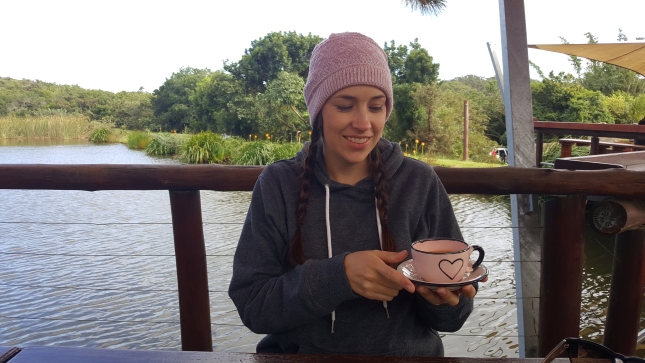 I learnt and discovered so much about myself throughout the journey. Having patience, respect, kindness and showing vulnerability and open-mindedness in situations helped me enjoy every aspect of the experience. While at times it was a bit of challenge, on the whole it was a wild adventure! Through conversations, observations and interactions I also gained so much more knowledge and understanding about the Xhosa community and their way of life as well as the beautiful landscape that we are so lucky to call home.
I learnt and discovered so much about myself throughout the journey. Having patience, respect, kindness and showing vulnerability and open-mindedness in situations helped me enjoy every aspect of the experience. While at times it was a bit of challenge, on the whole it was a wild adventure! Through conversations, observations and interactions I also gained so much more knowledge and understanding about the Xhosa community and their way of life as well as the beautiful landscape that we are so lucky to call home.
In the end, the reason for the trip was not to have a cushy holiday, but rather to educate ourselves and experience what life has to offer. We roughed it, we lay under the stars, we watched sunrises, we got lost, we ate food we weren’t used to, we walked in the rain, we took chances, we explored nature, we made friends, we tried new things, we indulged ourselves in the richness that is the Eastern Cape.
We’ll definitely be back! xx




























Reblogged this on Miss Mack.
LikeLike